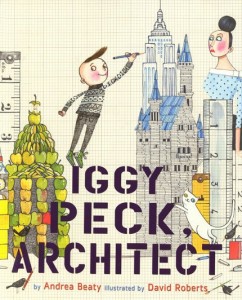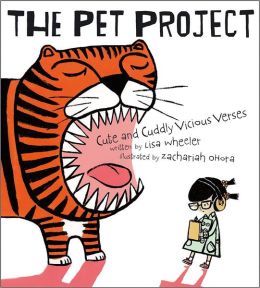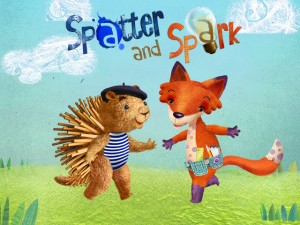Iggy Peck, Architect
 Long have I loved Andrea Beaty’s picture book series about a bear named Ted (grab Doctor Ted, Firefighter Ted, and Artist Ted from your local library and prepare to be charmed.) Then, I saw sitting on the shelf by the Ted books this gem, just waiting to tie in perfectly with science, math, and phonological awareness lessons.
Long have I loved Andrea Beaty’s picture book series about a bear named Ted (grab Doctor Ted, Firefighter Ted, and Artist Ted from your local library and prepare to be charmed.) Then, I saw sitting on the shelf by the Ted books this gem, just waiting to tie in perfectly with science, math, and phonological awareness lessons.
Iggy Peck, Architect written by Andrea Beaty and illustrated by David Roberts will grab young readers on page 1:
“Young Iggy Peck is an architect
and has been since he was two,
when he built a great tower – in only an hour –
with nothing but diapers and glue.”
The story about a young boy who loves to build and saves the day with his architectural skills is told in fantastic rhyme. (Hello, Common Core Standard of Phonological Awareness!) But the beauty of this book is that after you’ve used it in reading lesson, it inspires all kinds of science, art, and math extensions.
When his class is stranded on a small island, Iggy teaches his classmates how to construct a suspension bridge from “boots, tree roots and strings, fruit roll-ups and things”. After sharing Iggy Peck, Architect, pull out Bridges by Seymour Simon to learn more about suspension bridges and how they work (and pat yourself on the back for Integrating Knowledge and Ideas, you Core Standard wizard.) You may choose to forgo tree roots and boots, but challenge your students to plan and construct a suspension bridge, perhaps between two tables, with materials like string, paper, straws, etc. Students can use graph paper like David Roberts did when they draw up their plans, measuring actual distances and then scaling the distances down on paper before they build. Your students will be measuring, counting, drawing, predicting, and revising as they work. Keep architecture books like Bridges! Amazing Structures to Design, Build, and Test by Carol A. Johmann and Elizabeth J. Rieth, or the wonderful David Macaulay books on hand for those inspired by Iggy Peck. As Miss Lila Greer, the teacher in Iggy Peck, Architect realizes:
“There are worse things to do when you’re in grade two
than to spend your time building a dream.”
For more information about the author, go to andreabeaty.com.
For more information about the illustrator, go to davidrobertsillustration.com.
Read MoreMy favorite Earth Day book: Wangari’s Trees of Peace
 Sometimes I fear that I can’t make a real difference in helping the planet, but Wangari’s Trees of Peace: a true story from Africa by Jeanette Winter shows how powerful one person’s actions can be. Wangari Maathai was devastated to see how barren Kenya was after thousands of trees were cleared. Soil was eroding and crops wouldn’t grow. The birds were gone. Women walked for miles to gather firewood. “I can begin to replace some of the lost trees here in my own backyard – one tree at a time.”
Sometimes I fear that I can’t make a real difference in helping the planet, but Wangari’s Trees of Peace: a true story from Africa by Jeanette Winter shows how powerful one person’s actions can be. Wangari Maathai was devastated to see how barren Kenya was after thousands of trees were cleared. Soil was eroding and crops wouldn’t grow. The birds were gone. Women walked for miles to gather firewood. “I can begin to replace some of the lost trees here in my own backyard – one tree at a time.”
Wangari started with nine seedlings, which grew into a nursery. Wangari gave new seedlings to village women for them to plant, and gave them money to keep those trees thriving. When Wangari tried to stop the clearing of old trees, she was beaten and arrested. But her message of caring for the Earth was taking root just like her trees were, and because of her, Kenyan women planted over 30 million trees, saving their land and making life there better.
For Earth Day/Arbor Day/natural resources units/biography units/non-fiction read-alouds that you can finish in one sitting, this is my new go-to book. Just by reading it and discussing it with students, you’re hitting the Common Core Standard of Range of Reading (a biography that teaches science and social studies? Non-fiction score!) Wangari’s Trees of Peace is also excellent for an ecological cause-and-effect lesson, one of the big pieces of Key Ideas and Details. Using the book for reference, students can write and draw the effects of deforestation (crops wouldn’t grow, birds were gone, lack of firewood) and the effects of planting all those trees (women don’t have to walk so far to gather firewood, more birds, crops growing in the soil.) Winter’s picture book doesn’t delve deeply into the science of why a lack of trees leads to soil erosion, so you can share Planting the Trees of Kenya: the story of Wangari Maathai by Claire A. Nivola if you need to build that knowledge with your students. Use both books as resources for student writing and drawing, and now you’re Integrating Knowledge and Ideas!
If in the past you’ve received more apple-themed coffee mugs than you need as end-of-the-year teacher gifts, you can suggest that in lieu of a present for you, students can give a gift to us all by planting a tree. If you can spring for a seedling or if your parent-teacher organization will chip in, plant a tree with your students and let them help take responsibility for watering it (seeds are cool, but watering a visible seedling is way more exciting than watering a patch of dirt.) Wangari’s Trees of Peace may plant in your students a dedication to care for our planet.
Read More
The Pet Project
 As soon as I picked up this new poetry book, The Pet Project, I thought of the animal reports many of my students are doing and I knew I must get this book into the hands of those kids and their teachers! The Pet Project: Cute and Cuddly Vicious Verses written by Lisa Wheeler and illustrated by Zachariah Ohora begins with this ominous verse:
As soon as I picked up this new poetry book, The Pet Project, I thought of the animal reports many of my students are doing and I knew I must get this book into the hands of those kids and their teachers! The Pet Project: Cute and Cuddly Vicious Verses written by Lisa Wheeler and illustrated by Zachariah Ohora begins with this ominous verse:
Warning!
If you’re the type who oohs and ahhs
at furry faces, precious paws,
the words ahead may be alarming:
Animals aren’t always charming.
Considering that I’ve been giving stacks of informational animal books to teacher-friends for student research projects, this poetry book comes at exactly the right time. It’s poetry month (hello, Range of Reading Standard!) and each poem about a different animal just begs to be compared to an informational book that will confirm the cool, and sometimes gross, facts. (Integrating Knowledge and Ideas? Check!)
For example, if you’ve got students who’re interested in monkeys, share this gem:
Monkey
He looks so like a little man
with smiling teeth and grasping hand.
He chatters to his monkey friends,
but that is where the likeness ends.
His hair is full of bugs and lice.
He flings his poo – His aim’s precise.
His scream sounds like a banshee’s wail.
He swings from his prehensile tail.
And worst of all he smells so funky.
If he’s a man, then I’m a monkey!
After your students calm down from giggling over poo-flinging, the research-sparking discussion can begin. Do monkeys really fling poo? What does prehensile mean? Do monkeys really smell funky? Time to pull out the informational non-fiction books for a fact-finding expedition. I love that Wheeler never dumbs down her vocabulary (you’ll find query, devise, and formulate all in the second poem). Discussing all the wonderful words she chose will help you hit the Craft and Structure Standard. So one little picture book can help you teach three Common Core State Standards, kick off student-led research projects, enrich vocabulary, and strengthen the love of poetry. I think we’ve just found a new teacher’s pet in The Pet Project.
For more information on the author, please visit: lisawheelerbooks.com.For more information on the illustrator, please visit: zohora.com.
Read MoreSpatter and Spark – a free picture book app!
 Perhaps my dilemma is familiar to you. I have an iPad, and I want a great picture book app to share with early elementary students. With my tiny budget I’m always on the hunt for the free, but I also like good stuff, and unfortunately, that combination of free and good is often hard to find. Here’s an app that fits the bill – Spatter and Spark.
Perhaps my dilemma is familiar to you. I have an iPad, and I want a great picture book app to share with early elementary students. With my tiny budget I’m always on the hunt for the free, but I also like good stuff, and unfortunately, that combination of free and good is often hard to find. Here’s an app that fits the bill – Spatter and Spark.
Spatter and Spark is a free picture book app from Polk Street Press. It’s an original story written by the talented and rockin’ cool Deborah Underwood with superb illustrations by Luciana Navarro Powell. Spatter is an artistic porcupine who would like to paint a picture of the baby crow, Hubert, as a gift. The problem is that Hubert is not quite ready to fly down from his nest, so Spatter isn’t sure what Hubert looks like. Spatter asks his inventor pal, Spark, to help him with his problem. She suggests that if Hubert can’t come down, Spatter should go up. Spark invents bouncy shoes for her and Spark to wear and the problem seems solved – until they are bouncing too high! The reader helps to save the day, and that’s one of the best things about apps like this: they encourage reader interaction.
The art for Spatter and Spark is large enough for a whole class to enjoy, but I think it’ll be best used either in small groups or 1-to-1 because readers can help build and paint the bouncy shoes (Spatter is an artist and must make the shoes sparkly!) I love how the shoes we see Spatter and Spark wearing as they bounce are painted exactly the way I chose, a bit of tech magic that delights me. There are activities within the app that can be purchased, but I want to use this with students to talk about Key Ideas and Details.
This story starts with one problem, but one answer doesn’t automatically save the day; the solution leads to another problem. After sharing this picture book app with your students, have them fold or divide a piece of paper into thirds labeled First, Next, and Last (or keep it teched up by using a “show me” app like Educreations to write and draw). In the “First” third, students can show the original problem. In the “Next” third, students can show the solution to that problem, which also caused another problem! In the “Last” third, students can show how that second problem was solved.
Because Spark is an inventor, ask your students to get creative. Bouncy shoes were one way for the friends to get up high – what other ways might there be? Encourage students to draw (or create!) another invention that might work, and make sure to plan for any problems this new solution might cause. In honor of artistic Spatter, students should make the inventions beautiful as well as functional. (Gotta say, I love that the girl is the inventor and the boy is artistic!)
So if you have an iPad 2 or later, and you’re on the hunt for a free picture book that’s also high-quality, download Spatter and Spark!
For more information about Deborah Underwood, please visit: www.deborahunderwoodbooks.com.
For more information about Luciana Navarro Powell, please visit: www.lucianaillustration.blogspot.com.
For more information about Polk Street Press, please visit: www.polkstreetpress.com
Read More







